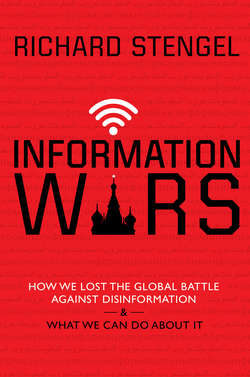Читать книгу Information Wars - Richard Stengel - Страница 14
На сайте Литреса книга снята с продажи.
The Marshall Office
ОглавлениеMy office was on the fifth floor of the original building. I shouldn’t say “my office”—it was the office of the Under Secretary of State for Public Diplomacy and Public Affairs, and it was a plum. In fact, it had been the office of Secretary of State George Marshall when the building first opened. The ceiling is 25 feet high (when my youngest son first saw it, he said, “Dad, you could have two basketball hoops on top of each other”) and featured three enormous, round lights that looked exactly like the flying saucers in the 1951 movie The Day the Earth Stood Still.
The office was a strategic asset in a city of beautiful offices. After all, people did make a correlation (inaccurate though it might be) between the size of one’s office and how much power one had. For that reason, I liked to have meetings with foreign ambassadors and ministers in my office, where I would serve tea and coffee and let them take it all in. (The office came with its own State Department china.)
There was another anomaly about the office, one that was not necessarily an advantage: it wasn’t on the seventh floor. The seventh floor was where the Secretary sat, as well as his two deputies and all the Under Secretaries except one: me. Yes, the seventh floor was a physical space, but it was also the mythic locus of power in the Building. The phrase “the seventh floor” was uttered hundreds of times a day at the State Department: “The seventh floor isn’t happy.” “The seventh floor wants to do the deal.” “The seventh floor is going up against the NSC.” Just as the phrase “the White House” is shorthand for the President, “the seventh floor” represented the Secretary of State.
My office was on the fifth floor and not the seventh thanks to the astute real estate sense of one of my predecessors, Judith McHale, who was Under Secretary for Hillary Clinton. In 2008, after she was sworn in, she was shown the dark, rather grotty office on the seventh floor where the Under Secretary for Public Diplomacy normally sat. At the same time, someone mentioned that the Marshall office on the fifth floor in the old State building had just finished its renovations and was available. Judith chose beauty over proximity to power, and almost every morning when I walked into that lovely space, I silently thanked her.
But because I was not physically on the seventh floor, I was constantly walking or trotting—and sometimes sprinting—to it for meetings. And it was a hike. The State Department was the most nonintuitive, mazelike structure I’ve ever worked in. One reason is that when the building was expanded in 1961, the new parts were grafted on to the old building in a completely inorganic way. To remedy that, the hallways were numbered and marked with a rainbow of colors. The legend was that Henry Kissinger had the halls painted different colors so that he could find his way around—though the idea that Secretary Kissinger was wandering the halls of the Harry S. Truman Building strikes me as implausible. I would leave early for meetings to factor in the time I would be lost. What helped one navigate is that there were enormous posters from different countries at the end of each hall. So I always remembered that my office was at the juncture of the picture from Thailand (a boy walking across a rope bridge over a river) and one of a Hindu temple in India, and that when I was going up to the seventh floor, I turned left at the picture of a snowy St. Basil’s Cathedral in Moscow.
Even after a decade in the building, foreign service officers would still get lost. But at least after a few months I stopped having to send text messages to my staff to come and rescue me. Like so many people there, I figured out a few different ways to get to where I had to go and then stuck to those paths religiously. It was a little like diplomacy.
